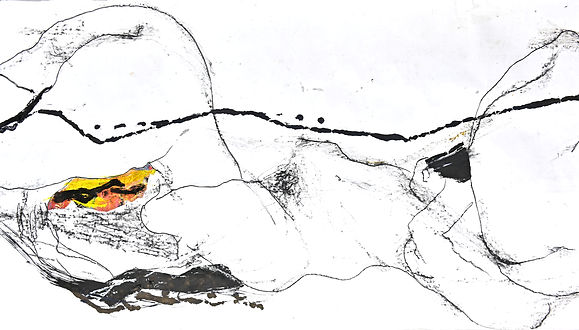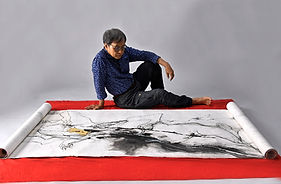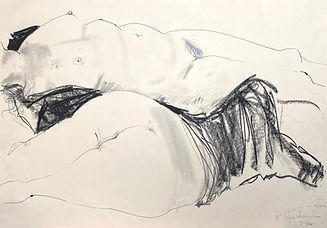
Highlights
Step into the mesmerizing world of contemporary Japanese erotica, where the depth of tradition intertwines with the daring spirit of experimentation in a captivating exploration of desire and artistry. Our curated collection showcases an exquisite range of works, from lavishly detailed hanging scrolls to tenderly expressive drawings, each celebrating the profound sensuality and poetic simplicity that lie at the heart of Japanese aesthetic traditions.
Rooted in the evocative allure of the Edo period's ‘floating world’ (ukiyo-e) paintings, these artistic creations (art forms) transcend their historical origins, reinventing themselves with bold and contemporary interpretations that speak to modern sensibilities. Each piece is a testament to the enduring power of the human body as a medium of artistic exploration, blending timeless elegance with daring innovation.
Among the Highlights of this collection is an exceptionally rare hanging scroll by Keisuke Watanabe, an extraordinary piece measuring 90 cm wide and an astonishing 23 meters long. An unusual format even in Japan, this dynamic scroll, meticulously painted using real-life models, unfolds a visual narrative that captures the flowing movement of the human body and the ephemeral passage of time. A stunning fusion of Shunga tradition and a modern, audacious vision, it invites viewers into a deeply immersive experience.
Alongside the grandeur of the scrolls, discover the intimate charm of smaller-scale drawings, where intricate lines and subtle tones capture fleeting moments of beauty, desire, and form. These works, rich in nuance, reward careful contemplation, revealing the delicate interplay between restraint and passion.
We invite you to our gallery to explore this evocative celebration of the human body and to have an unforgettable encounter with Japanese art at its most intimate, refined and compelling way.
Works Presentations
Music Exists - Bare M: A Scroll by Keisuke Watanabe
2006, Salzburg
Drawing, collage on paper scroll, Japanese ink, charcoal, crayons, gouache paint

Keisuke Watanabe's scroll, Music Exists - Bare M, captures an experience both unique and profound from his time in Salzburg in 2006, during the 250th anniversary celebration of Mozart’s birth. Immersed in the vibrancy of the festival, Watanabe was privileged to witness iconic operas like Don Giovanni, Idomeneo, and The Abduction from the Seraglio—but from an entirely unconventional perspective: backstage. One particular element of the festival’s performances struck him deeply; due to the sponsorship of an Austrian lingerie brand, many scenes featured dancers and singers half-dressed, creating a visual blend of elegance and sensuality that was both liberating and evocative. This experience left a lasting impression on him.
The city of Salzburg itself became a mesmerizing venue, with concerts, operas, and exhibitions unfolding in every corner. At one such exhibition near the festival venue, Watanabe encountered a video installation depicting Mozart, or perhaps a figure reminiscent of him, lying bare in a bathtub. This unconventional portrayal left Watanabe inspired, planting the seed for Music Exists - Bare M.
For this piece, Watanabe worked with live models from the Academy of Fine Arts in Salzburg, which provided models in the spirit of artistic exploration. Through Watanabe’s signature use of bold lines and delicate strokes, Music Exists - Bare M exudes the same liberating energy and sense of playful reverence he experienced in Salzburg. His brushstrokes seem to capture the rawness of both music and the human body, blending them in an intimate, flowing narrative that brings forth a scene rich with movement, sensuality, and freedom.
Music Exists - Bare M is a piece that transcends time and place, embodying the spirit of artistic freedom that Salzburg ignited in Watanabe and bringing to life his distinct interpretation of music, body, and artistic expression.


Sketches





Keisuke Watanabe, a distinguished figure in contemporary Japanese erotic art, creates works defined by extraordinary lightness and instantaneity. Rendered with stunning sensitivity and aesthetic austerity (aestheticism), his art displays an effortless virtuosity and elegance. Using smoky shades of black ink and simple (minimalistic) line, Watanabe channels refined sensuality and elegant simplicity, hallmarks of Japanese aesthetic discourse, imbuing each piece with with an air of erotic intrigue and sophistication.
Inspired by the allure of Shunga, or “pictures of the floating world”—an art form that celebrates the elegance and erotic charm of courtesans while bodly depicting scenes of intimacy—Watanabe’s work merges Japanese heritage with nuanced European influences. His intricate linework and symbolic gestures echo artists like Egon Schiele, infusing the compositions with layers of erotic intensity and a voyeuristic fascination that heightens the emotional resonance. This fusion deepens the works’ exploration of human desire and vulnerability, revealing both their sensual and poignant dimensions.
The artist’s process is deeply influenced by his background as a professional musician, viewing drawing as a temporal art form akin to music. Principles he learned from music—such as “the horizontal axis as the flow of time,” “change and unity,” and “tension and relaxation”—have become foundational to his painting, guiding the structure of his compositions. Much like in classical music, where breaking from the basics allows for innovation, he transcends traditional boundaries in search of new forms, capturing both the passage of time and the dynamic movement of the human body.
This focus on temporality is amplified by his close work with live models. Positioned at a distance where an outstretched arm might graze the model’s skin, Watanabe emphasizes immediacy and visceral connection. He immerses himself in the model’s warmth, breath, and scent, which informs the raw intensity of his pieces. This proximity naturally results in visual distortions, animating the body with an aggressive energy that evokes a deeply felt experience. By working so closely with live subjects, Watanabe captures fleeting moments of authentic, unguarded expression—moments that, though erotic, reveal poignant vulnerability. This vulnerability adds depth, inviting the viewer into an experience that transcends physical allure to explore the emotional nuances of intimacy.
Watanabe’s large-scale scrolls, some reaching up to 12 meters in length, embody his belief that “life is in the lines.” Through sweeping, elongated strokes, he captures the essence of fluid movement, as if each line breathes with vitality. These scrolls, always inspired by live subjects, offer an immersive experience of intimacy and transformation, mirroring the chaos and vibrancy of life itself. A striking example is his depiction of Pina Bausch’s The Rite of Spring, where he conveys the pulsing energy of dancers in rehearsal, twisting and writhing to the fierce rhythms of Stravinsky.
Watanabe often works with unusual tools, infusing his art with a raw, organic quality. For instance, he sometimes begins compositions with arcs drawn using gomagi—wooden sticks burned in the homa ritual—adding a layer of spiritual depth. His extensive travels have further influenced his approach: he has sketched with water from the Ganges in India and incorporated cinders from a forest fire in Australia. This spontaneous use of materials enriches his work with a sense of place and ritual, grounding his abstract expressions in tangible, lived experiences.
Watanabe’s artistry transcends conventional boundaries, with each piece evolving into a tableau vivant—a living scene that captures the elegance of human movement, the true soul of his paintings. His work evokes a seamless interplay of rhythm and emotion, drawing viewers into an immersive experience that borders on the theatrical. Through his mastery of line and form, he creates scenes suspended in time, inviting deep engagement with the dynamism and sensuality that define his vision.


